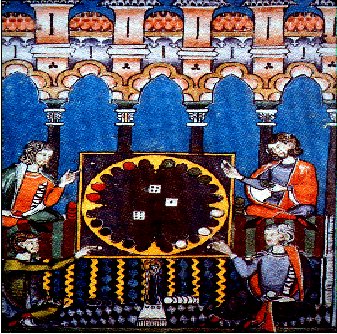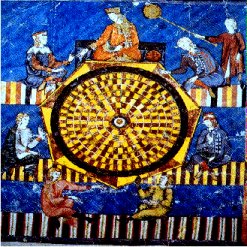 A number of backgammon games are illustrated in the Libro de Juegos, some with detailed explanations. The graphic to the right is one of these.
During Alfonso's time,
in the Muslin world backgammon was called Nard, while in other parts of Europe it was known as
"Roman tables" or tabulae. When the game is played with three dice, it is thought that it evolved from the Roman version.
A number of backgammon games are illustrated in the Libro de Juegos, some with detailed explanations. The graphic to the right is one of these.
During Alfonso's time,
in the Muslin world backgammon was called Nard, while in other parts of Europe it was known as
"Roman tables" or tabulae. When the game is played with three dice, it is thought that it evolved from the Roman version.
In The Backgammon Book (New York: Viking Press, 1970), Oswald Jacoby and John R. Crawford explain:
"The history of backgammon is long, complicated, very incomplete - and fascinating. The exact origins of the game remain unknown, through there is much conjecture, a good deal of it both ingenious and farfetched... The Roman Legions must have brought tabulae with them through Europe... the return of the Crusaders that effectively spread the game throughout Europe."

However, according to Parlett, Oxford History of Board Games, 1999, Nard, a Middle-Eastern board game is identical with backgammon. First mentioned about the 7th century AD in the Babylonian Talmud, Parlett reports that "Nard was adopted by the Arabs and became popular throughout the Muslim world... Nard as described in the Alfonso MS of 1283 is recognizable ancestral Backgammon, but in the absence of earlier rules one can only assume that it was substantially similar."
It is also obvious in examining other pages of the Libro de Juegos that during Alfonso's time a number of variations of backgammon were played. The graphic above indicates that one of these was a type of backgammon on a "round" board, and was a game for four players.
But as the poet said, "Why be content with the olive when you can have the whole tree?" These two illustrations from the Libro de Juegos illustrate there was a version of the game for seven players. That's Alfonso at the top of the picture on the left.
 |

|
Today around the world, the standard backgammon game is for two players. There are a number of backgammon sets in the virtual collection. Click on the item in the left panel to see some examples from the collection.
Last update February 11, 2010